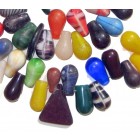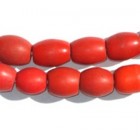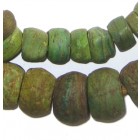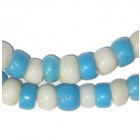
“Mali Wedding Beads” collectively refers to a variety of bulbous and colorful Czech trade beads manufactured in Bohemia (now Czechoslovakia) between the 19th and 20th century. Their name derives from the popularity among the Fulani people of Mali, who traditionally present them to their daughters on the eve of her wedding.

Mali Wedding Beads
Mali Wedding Beads are among the earliest types of Bohemian trade beads to be produced using the mechanical pressing method, originally patented in France by Jean-Felix Bapterosses in 1843. Molten glass is distributed into molds, then fired under pressure to achieve a uniform shape. Pressed beads typically have a visible seam running the entire perimeter of the bead, although in the case of Mali Wedding Beads, was often ground down by hand to achieve a smooth finish.
“Fulani Wedding Beads”, as they are also known, come in a wide range of sizes and shapes. The most common varieties resemble pineapples and light bulbs, with a horizontal perforation at the top, however, they were also produced in triangular and ‘claw’ shapes. Hourglass and pineapple beads are highly prized by women of the Fulani tribe, since they closely resemble the female form. In rural parts of Mali, such beads are still believed to aid female fertility.
Early Mali Wedding Beads were typically produced in opaque, single colors, however, as technology advanced, Czech glass-makers began to experiment with different combinations to produce both striped and speckled varieties. Today, Mali Wedding Beads can be found in just about every shade of the spectrum, with a wide range of effects and finishes.
Colodonte Beads (also known as “tomato”, “pigeon egg” and “hummingbird egg” beads) are a type of wound, drawn bead originally produced in Bohemia (now Czechoslovakia) during the 1900s. The modern nicknames given to these beads derive from the fact they bear a close resemblance in shape to the eggs of small wild birds. Early Colodonte Beads were predominantly opaque red or burnt orange in color – hence their sometimes being referred to as “tomato beads”.

Red Colodonte (Tomato) Beads
The mysterious history of Colodonte Beads has led to considerable speculation in online forums as to their intended use. The name “Colodonte” is believed to be of Italian origin; “colo” deriving from the Italian word “colore” (meaning color), and “donte”, which loosely translated means “everlasting”. However, there is no evidence to suggest that these beads were produced in Venice, lending credibility to the theory that artisans in Bohemia may have been producing them specifically for Italian merchants to use as currency overseas. The vast majority of old Colodonte Beads sold today originate from present day Mali and other coastal parts of West Africa.
Colodonte Beads are distinguishable from other Bohemian Trade Beads by their oval shape and smooth finish. The blemish free, glossy skin of the beads is similar in appearance to tomato skin – perhaps another reason they earned the moniker “tomato beads”. Nearly all trade beads of this type are round or oval in shape, however can vary in size from 20 – 40 mm in diameter. Colodonte Beads manufactured during the 19th Century typically suffer minor pitting – a tell-tale sign of their age and fascinating history.
Green Heart Beads (also known as “Hudson’s Bay Trade Beads”, or more simply “Green Hearts”) are a collectible variety of Venetian trade bead produced between 1480 and the 1800′s in Murano, Venice. They are descended from the two-tone compound beads known as “White Hearts” or “Cornaline D’Aleppo”, which were manufactured exclusively as a medium of exchange (currency) for furs in North America and Africa by the Hudson’s Bay Trading Company.

Old Green Heart Trade Beads.
Green Heart Beads are distinguishable from Cornaline D’Aleppo by their brick red color and translucent green core. White Hearts are typically ruby or scarlet red with a translucent white or gray core. The coloration of these popular Venetian glass beads was achieved by adding gold oxide to pink or purple glass. Initially, glass-makers were using gold oxide to produce beads in red only (possibly to imitate the popular carnelian beads traded in Africa), however this proved too expensive long-term. They decided to produce cheaper beads by creating a translucent core from untreated glass, and simply coating it with a thin layer of red colored glass. Green was used for the core until 1830, after which white and yellow glass were used.
Like Cornaline D’Aleppo, Green Heart Beads were produced in limited quantities between 1480 and 1830 due to the sheer expense involved. Because of their scarcity, they’re widely considered to be some of the most valuable and collectible types of trade beads on the market today.
White Heart Beads (also referred to as “Cornaline D’aleppo“, or “Hudson’s Bay Beads”) were a type of Venetian Trade Bead produced in Venice, Italy, between 1805 and 1900. While highly collectible, these two-tone beads are considerably plainer compared to other sought after trade beads of the time, such as Millefiori Beads, with an off-white or light yellow core enveloped by a skin of scarlet, orange or dark red glass. Historical findings suggest the brilliant red of some White Heart Beads was achieved by adding gold oxide to the glass.

Red White Heart Beads (Cornaline D’Aleppo)
White Heart Beads were traded extensively throughout Africa and North America in the 19th Century, however, the name “Cornaline D’Aleppo” is believed to derive from the old trading town, Aleppo, in Syria. Being a popular stop-off for caravanning merchants en route to the Middle East from the Mediterranean, the town became a thriving marketplace, and an important center for trade between nomadic African tribespeople and Europeans. “Cornaline”, the old French word for “carnelian”, suggests the beads could have been produced as imitations to fool African tribes.
Venetian White Heart Beads tend to be round or oval in shape, however, there is evidence to suggest both the French and Czechs produced similar beads in the 19th Century in a wide range of shapes and sizes. Although similar in aesthetics to White Hearts, Green Heart Beads usually have a green or grayish core.
King Beads are a type wound Venetian trade bead produced throughout the 19th and 20th Century in Murano, Venice, primarily for trade with Africa and America. They are distinguishable from striped Chevron Beads by their bicone shape, and the fact they do not feature a rosetta around the perforation hole. African legend tells that King Beads got their name because of their popularity among tribal chiefs up until the 1970s.
The earliest known examples of King Beads feature on numerous sample cards donated by Moses Lewin Levin to the British Museum around 1865. Early 20th Century King Beads (dated 1920) also feature within a collection of sample cards donated by Sick and Co; a German company who, until 1964, were one of Europe’s largest exporters of Trade Beads to Africa.
King Beads are one of the earliest types of biconical Trade Bead to have been produced by the marvering method. A marver is a long, thin rod made of copper, around which heated glass is slowly wound. A paddle or steel flipper is used to shape the glass whilst hot, and trails of colored glass then applied to create the distinctive polychromatic stripes. Nineteenth century King Beads were commonly produced in black, green and yellow varieties, with trailed horizontal stripes in two to three colors.
References:
King Beads, About African Beads
French Cross Beads (also known as “Bodoum Beads” in parts of West Africa) were a popular type of wound Venetian Trade Bead produced in limited quantities throughout the 19th Century. Their intended purpose was use as a medium of exchange or currency in new territories, such as Africa and South America, although they also found their way to parts of Asia in the early 20th Century.

Yellow and White French Cross Beads
So called because of the distinctive polychrome cross designs on their outer skins, French Cross Beads realized considerable value among tribes along the Ivory Coast and central Mali. They were produced in both yellow and white – the latter being far more scarce than the colored varieties. While most beads featured a single cross design in one or two colors on either side of the bead, others were decorated with trailed and cross-hatched designs. French Cross Beads were produced in a variety of sizes ranging from a tiny 5mm to just over 12mm.
The production of Bodoum Beads involved an ancient bead-making technique known as winding or marvering. Glass is first heated in a furnace to make it ductile, then whilst still hot, is slowly wound around a copper mandrel coated in clay or borum nitride. This would form the bead release, which made it easier to ‘release’ the beads later on. While the glass was still hot, it would be manipulated with a flat-sided paddle to achieve the spherical shape. Finally, thinner strips of hot glass would be applied to create the cross design.
Much like old Venetian King Beads, French Crosses were only produced in limited number, and were therefore considered particularly valuable by tribes in Africa owing to their scarcity. They were commonly exchanged for valuable elements, such as gold and silver, as well as heavy animal pelts and palm oil. Today, French Cross Beads are still considered quite valuable, and can fetch between $50 and $300 at online auction.
References:
Wound Glass Beads – Wikipedia
French Cross Beads - About African Beads

Green Hebron Beads
Hebron Beads (sometimes referred to as Kano Beads) are a form of glass Trade Bead which originate from the Holy city of Hebron in Palestine. The city is rather better known as the final resting place of the patriarchs and matriarchs of the Jewish, Muslim and Christian faiths, however, also has a long and fascinating history of glass-making which dates back to 63 BCE. These early glass beads were blown spheres of round glass, simply decorated with evil eye designs to ward off malevolent spirits. Hebron Beads are typically donut-shaped with a far courser finish.
The earliest known beads produced in Hebron for trade were manufactured during the 18th Century. British explorer William George Brown references two different sizes of bead – Hershe and Munjir – produced in the region in his journal of 1799, with further observations detailing their course texture and rustic finish. Their eroded aesthetic derives from the fact that they are made with salts from the Dead Sea, and sand from the outlying village of Bani Na’im.
As trade networks developed between Africa, Palestine and Egypt in the early 1800s, Hebron’s glass-makers began producing beads exclusively for trade in foreign lands. They were particularly well received by the Igbo and Yoruba tribes of Kano, Nigeria, both of whom consider large, heavy beads to be indicative of wealth and social status. The Yoruba, however, noticed that the rough glass beads did not sit uniformly when strung upon a raffia, and so ground down the sides of the beads themselves using flattened stones. Early historians were originally of the impression the beads were produced by the Yoruba – hence the name “Kano Beads”.

Antique Blue and White Padre Beads
Padre Beads (also known as “Peking Glass”) are a type of wound glass Trade Bead used as a medium of exchange for furs in Africa and America between the 1650s and 1920s. Their official country of origin is China, where they were produced exclusively for the costumes of Chinese courtiers during the Ching Dynasty. Latterly, they were manufactured throughout Europe – notably in France and Venice. The humble Padre Bead was first used in trade around the early 18th Century, exported via China to Europe for use by explorers developing trade links with American Indians.
Padre Beads are so named because of their use as prayer beads among Spanish friars and monks. These later beads were of European origin, and were first introduced to Africa by Franciscan monks carrying out missionary work along the Gold Coast. In North America, traders found that the Nez Perce Indians particularly coveted the turquoise blue wound beads over others because it reminded them of the sky (heaven). This was further documented by English explorer Captain James Cook in 1778, whom wrote of his difficulty in obtaining supplies from the Indians without this specific “chief bead”.
Despite the popularity of turquoise and white beads among the Nez Perce, they were actually produced in a wide spectrum of colors. European Padre Beads were also manufactured in three distinct sizes: Dogons, which could be up to ¾ of an inch in diameter; Crows, which measured approximately 3/8 of an inch, and Pony Beads, which were a mere 3/16 of an inch in size. Padre Beads are typically wider than Dutch Dogons, yet smaller than wound Hebron Beads.
Dogon Beads (also referred to as “Dutch Dogons”) are a type of Trade Bead found in abundance in the town of Bandiagara, Mali. They are so named because of their popularity among the Dogon people of Mali; an ethnic group which makes up over 70% of the Mopti region’s populace.

Blue Dogon Beads
Dogons found their way to Mali in the 19th Century aboard merchant ships. Prior to this, they were manufactured in Amsterdamexclusively for decorative use in mosaic gardens in the Zaanstreek District of the city. Spurred by an increased demand for Trade Beads by tribes in Africa, glass-makers began producing the small donut beads in far greater quantities for use as a medium of exchange. Historical records show that the vast majority of Dogon Beads manufactured for export ended up in either Mali, or along the Gold Coast; exchanged with local tribal leaders for favors, slaves, furs and exotic spices.
Unlike many Trade Beads, Dutch Dogons were named after the tribespeople of the Mali region. It is believed this may be due to the fact that Dogon people took it upon themselves to further manipulate the beads by wearing down the sides, so that they would sit more uniformly upon a length of sisal. Early Dogon Beads were quite crudely made. They often featuring a raised area around the perforation hole – the result of a laborious winding process. Most Dogon Beads sold today have been re-shaped by Mali dealers, allowing them to be easily strung upon necklaces and bracelets as spacers.
References:
Padre Beads, Dixon’s Trade Bead Encyclopaedia.
About Padre Beads, AboutAfricanBeads.com
Chevron Beads (also known as “rosetta” beads, or simply “Chevrons”) are a type of Venetian Trade Bead produced in Murano and Venice, Italy, from the 14th to 19th Century. Venetian Chevrons are categorized as ‘drawn’ beads; created by fusing multiple glass canes which are shaped using specialist star molds. This creates a distinctive star shape around the perforation hole (usually comprising 4-7 colored layers), which is often referred to as a “rosetta”. Chevron Beads produced during the 15th Century typically had 7 layered colors and 6 facets.
Chevron Beads comprise numerous layers of colored glass. The core of the bead, which will later form the perforation, is created from a single globule of molten glass, known as the “gather”. While still hot, the gather is immersed into a star shape mold to add the first layer of color. This process is repeated to achieve each colored layer. After several colors have been layered consecutively, the glass is drawn out, or pulled with a cane to elongate the rod, which is then cut whilst hot to form the beads. The end of the beads are then chamfered or ground to reveal the star pattern in the cross section. Early Chevron Beads were almost always red, white and blue in color.
Venetian Chevrons are among the earliest known types of beads to be produced in Venice for trade in West Africa. They were primarily intended for use as currency in unexplored territories, such as the Republic of the Congo, where merchants would exchange them for favors, animal pelts, slaves and spices. A number of small, 7 layer Chevron Beads dating back to the 15th Century have been found in Peru, and were believed to have been introduced by Christopher Colombus. Today, classic 7-layer Chevron Beads are the most highly collectible.
References:
Gallery of Trade Beads, Ezakwantu
Chevron Beads, Wikipedia